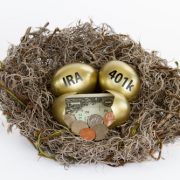Inflation Hedges: How Real Estate and Precious Metals Help Protect Your Retirement
When retirement investors talk about “inflation hedges,” what does that mean? On one level, it means that it is important to own property that will retain value, even if the value of the dollar plummets over time. And given that the goal for inflation is about 2% per year, it is probably safe to say that inflation is going to happen. But how can a Self-Directed IRA help investor who worry about inflation, and why does it matter?
How Inflation Works: A Brief Primer
According to recent numbers, the inflation rate is steady at about 1.7%. And while this is a relatively stable number, it is also important to consider what this means to retirement investors. If you were to stock away a hoard of cash in a drawer somewhere, that money will steadily decrease in value by a rate of about 1.7% per year if inflation continues at this pace. And that is a best-case scenario for inflation, which economists work hard to keep under control.
In periods of rampant inflation, the value of the money you set aside decreases at an even sharper rate. It then becomes more costly to rent, buy gas, shop for groceries, pay for basic necessities, and more. The simple goal of most investors is to outpace inflation with well-timed investments that return far more than the rate of inflation.
A Self-Directed IRA is one possible vehicle for doing this. But it is not just another vehicle for beating inflation. It may be one of the best. Someone with a Self-Directed IRA can use retirement funds to invest in asset classes that are notoriously good at holding on to their value no matter what happens in the world of inflation. In particular, those asset classes include real estate and precious metals.
How Do Real Estate and Precious Metals Hold on To Value?
Personal finance gurus often point to the historical returns of gold as an example of it being a conservative investment. But that often misses the point. Gold is not a stock that you invest in and hope for 20% returns over 30 years. Instead, gold can have individual swings that are highly profitable to investors who see that inflation might be on the horizon. As gold is priced in dollars, the weaker the dollar gets, the more dollars it takes to purchase gold. That means that if you own gold within a Self-Directed IRA, you then have a hedge against inflation.
The same is true in real estate. Unless an investment is timed very poorly, or placed in a terrible location, it can be hard to lose money in real estate over a well-planned, long-term future. Real estate tends to hold on to its value for a number of reasons, one of which is that people will always need housing. Just like any other investment, real estate can go up and down (as we saw in 2008). But with a well-timed investment, real estate tends to hold on to its value, hedging against the swings in the value of the dollar or in the stock market.
Making a Hedge Portfolio Work
As a Self-Directed IRA administration firm, American IRA does not make specific investment recommendations. We cannot point to the exact percentage of gold and real estate in your portfolio that will be ideal for you. But if you understand the roles of these asset classes—and how it might play into a retirement portfolio—you stand a better chance at success.
Interested in learning more about Self-Directed IRAs? Contact American IRA, LLC at 866-7500-IRA (472) for a free consultation. Download our free guides or visit us online at www.AmericanIRA.com.










